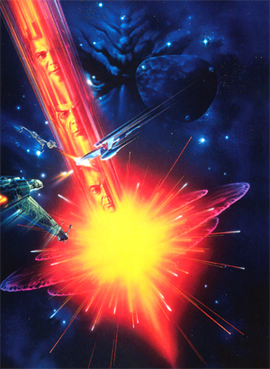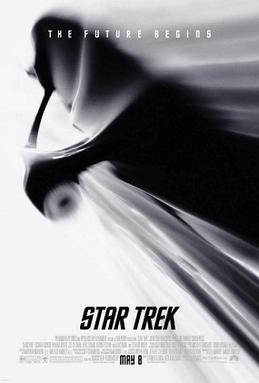I've never actually really watched a single episode of Star Trek so I did some research online to educate myself on this spendid TV series before watching the movie when it's released this coming Thursday, May 7 2009. And seriously I did not have any idea that Star Trek had THAT long of history!
Overview:
Star Trek is an American science fiction entertainment series and media franchise. The Star Trek fictional universe created by Gene Roddenberry is the setting of six television series including the original 1966 Star Trek, in addition to ten feature films with an eleventh completed to be released on May 8, 2009. The franchise also extends to dozens of computer and video games, hundreds of novels and instances of fan fiction, several fan-created video productions, as well as a themed attraction in Las Vegas. Beginning with the original TV series and continuing with the subsequent films and series, the franchise has created a cult phenomenon and has spawned many pop culture references.
The Television series
The Original Series (1966–1969)
*oh my! That's quite old~~~*
 Star Trek (Also known as "TOS", The Original Series) debuted in the United States on NBC on September 8, 1966. The show tells the tale of the crew of the starship Enterprise and its crew's five-year mission "to boldly go where no man has gone before." The original 1966-1969 television series featured William Shatner as Captain James Tiberius Kirk, Leonard Nimoy as Spock, DeForest Kelley as Dr. Leonard "Bones" McCoy, James Doohan as Montgomery Scott, Nichelle Nichols as Uhura, George Takei as Hikaru Sulu, and Walter Koenig as Pavel Chekov.
Star Trek (Also known as "TOS", The Original Series) debuted in the United States on NBC on September 8, 1966. The show tells the tale of the crew of the starship Enterprise and its crew's five-year mission "to boldly go where no man has gone before." The original 1966-1969 television series featured William Shatner as Captain James Tiberius Kirk, Leonard Nimoy as Spock, DeForest Kelley as Dr. Leonard "Bones" McCoy, James Doohan as Montgomery Scott, Nichelle Nichols as Uhura, George Takei as Hikaru Sulu, and Walter Koenig as Pavel Chekov.In its first two seasons, it was nominated for Emmy Awards as Best Dramatic Series, and Leonard Nimoy received nominations all three years for acting. Individual episodes won two Hugo Awards and six additional nominations in 1967-68, and a WGA Award for Best Dramatic Episode in 1968.
After three seasons, however, the show was canceled and the last original episode aired on June 3, 1969. The series subsequently became popular in reruns and a cult following developed, complete with fan conventions. Originally presented under the title Star Trek, it has in recent years become known as Star Trek: The Original Series or as "Classic Star Trek" — retronyms that distinguish it from its sequels and the franchise as a whole. All subsequent films and television series, except the animated series of the 1970s and the earlier seasons of Enterprise, have had secondary titles included as part of their official names. A re-release of the series began in September 2006 with computer-generated imagery "enhancements" as a high-definition "Remastered" edition. The entire series has been remastered. The remastered episodes currently air in syndication while the originals appear on many countries' channels although these broadcasts are infrequent and irregular.
The Animated Series (1973–1974)
*still an old piece =p*
 The U.S.S. Enterprise in this series, while supposedly the same ship as from the original series, had a holodeck very similar to the one introduced on Star Trek: The Next Generation, which was set approximately 80 years later. It only appeared once, in Chuck Menville's "The Practical Joker" and was known as the "Rec Room." This feature was originally proposed for the original series (see, e.g., Gerrold, The World of Star Trek) but was never used.
The U.S.S. Enterprise in this series, while supposedly the same ship as from the original series, had a holodeck very similar to the one introduced on Star Trek: The Next Generation, which was set approximately 80 years later. It only appeared once, in Chuck Menville's "The Practical Joker" and was known as the "Rec Room." This feature was originally proposed for the original series (see, e.g., Gerrold, The World of Star Trek) but was never used.Filmation later went on to produce the hit He-Man and the Masters of the Universe (1983-85), which occasionally used modified character and set designs from Star Trek: The Animated Series, mostly as background material. (He-Man and the Masters of the Universe also had several Trek-similar stories, most notably "The Arena", which is very similar to Star Trek: The Original Series's first season episode, "Arena"). Later series also shared many of the stock sound effects from both Star Trek: The Animated Series and Star Trek: The Original Series. Filmation also recycled some of the background music for Star Trek: The Animated Series in their later shows Shazam!, Tarzan and the Super 7 and Sport Billy. (Some of the music had already been reused from the previous season's Brady Kids and the Treasure Island feature, and were shared with that season's Lassie's Rescue Rangers).
The Next Generation (1987–1994)
*FINALLY I'm almost born!*
 The episodes follow the adventures of the crew of the Galaxy-class USS Enterprise NCC-1701-D. As the United Federation of Planets flagship, the Enterprise is designed for both exploration and diplomacy but is also formidable in combat situations if necessary.
The episodes follow the adventures of the crew of the Galaxy-class USS Enterprise NCC-1701-D. As the United Federation of Planets flagship, the Enterprise is designed for both exploration and diplomacy but is also formidable in combat situations if necessary.Patrick Stewart's voiceover during each episode's opening credits was patterned after that of the original series, but the phrase "continuing mission" replaces Star Trek's "five year mission", and the gender-neutral phrase "no one" replaces "no man":
"Space: the final frontier. These are the voyages of the starship Enterprise. Its continuing mission: to explore strange new worlds, to seek out new life and new civilizations, to boldly go where no one has gone before."
The Enterprise's crew contact and discover many races and species with whom they interact as a means of exploring the "human" condition. Dramatic devices such as time travel or temporal loops, natural disasters, holodeck malfunctions, and other internal and external conflicts often occur without alien encounters, though these, too, are used to explore issues of humanity.
Deep Space Nine (1993–1999)
*oh ya! I was only 4!*
 In the first episode, Starfleet Commander Benjamin Sisko takes charge of Deep Space Nine. He and Jadzia Dax stumble upon the first stable wormhole ever found and discover that it is inhabited by beings who are not bound by normal space and time. To the strongly religious people of Bajor, the wormhole aliens are their gods (the Prophets) and the wormhole itself is the long-prophesized Celestial Temple, where they reside. Sisko himself is hailed as the Emissary of the Prophets, through whom the Prophets primarily act.
In the first episode, Starfleet Commander Benjamin Sisko takes charge of Deep Space Nine. He and Jadzia Dax stumble upon the first stable wormhole ever found and discover that it is inhabited by beings who are not bound by normal space and time. To the strongly religious people of Bajor, the wormhole aliens are their gods (the Prophets) and the wormhole itself is the long-prophesized Celestial Temple, where they reside. Sisko himself is hailed as the Emissary of the Prophets, through whom the Prophets primarily act.This provides the basis for a long-lasting story arc. Sisko initially considers his role as a religious icon with open discomfort and skepticism, referring to the Prophets simply as "wormhole aliens" and striving to keep his role as commander of the station distinct from any religious obligations that the Bajorans try to place on him. Later, he becomes more accepting of his role and, by the end of the series, he openly embraces it.
Voyager (1995–2001)
*my primary school days~*
 In the pilot episode, "Caretaker," Voyager is on a mission to locate a missing ship piloted by Maquis fighters. Janeway brings Tom Paris, a former Starfleet officer, out of prison to help find the ship. Maneuvering through the dangerous Badlands, an ancient alien known as the Caretaker transports Voyager to the Delta Quadrant, 70,000 light years on the other side of the galaxy, where the Maquis ship was also sent. In the process, several members of Voyager's crew are killed, including the first officer, helmsman, chief engineer, and all medical personnel.
In the pilot episode, "Caretaker," Voyager is on a mission to locate a missing ship piloted by Maquis fighters. Janeway brings Tom Paris, a former Starfleet officer, out of prison to help find the ship. Maneuvering through the dangerous Badlands, an ancient alien known as the Caretaker transports Voyager to the Delta Quadrant, 70,000 light years on the other side of the galaxy, where the Maquis ship was also sent. In the process, several members of Voyager's crew are killed, including the first officer, helmsman, chief engineer, and all medical personnel.Voyager and the Maquis ship are attacked by Kazon raiders intent on capturing the Caretaker's Array, which was used to transport the ships. The Maquis ship collides with a Kazon ship, destroying both, after the Maquis crew transports to Voyager. Believing the Kazon will use the Array to harm the Ocampa, Janeway decides to destroy it rather than use it to return home.
Enterprise (2001-2005)
*I was just about to graduate from primary school!*
 Star Trek: Enterprise (originally titled Enterprise prior to the third season), produced for an abbreviated four seasons airing from September 26, 2001 to May 13, 2005, is a prequel to the other Star Trek series, taking place in the 2150s, some 90 years after Zefram Cochrane developed the first warp-capable starship from a ballistic missile and about a decade before the founding of the Federation. The series shows how the first extraterrestrial contact with the Vulcans and subsequent guidance led to Earth's first warp-five capable starship, the Enterprise, commanded by Captain Jonathan Archer (Scott Bakula). For the first two seasons, Enterprise is mostly episodic, like the original series and The Next Generation. The third season's "Xindi mission" arc carried through the entire season. Season 4 was especially known for showing the origins of several common elements in the other series, due to the producers having recruited as writers Trek experts Mike Sussman and the writing team of Judith and Garfield Reeves-Stevens. In addition, season 4 rectified and resolved some core continuity problems in the series (some of which were created in season 1 of Enterprise), most notably the decades-old issue of the drastic change in the appearance of the Klingons between TOS and other Trek series. The fourth season's story arcs are often spread to two or three episodes. Ratings for Enterprise started strong but declined rapidly, although longtime viewers were pleased by the final season's many homages to other Trek series.
Star Trek: Enterprise (originally titled Enterprise prior to the third season), produced for an abbreviated four seasons airing from September 26, 2001 to May 13, 2005, is a prequel to the other Star Trek series, taking place in the 2150s, some 90 years after Zefram Cochrane developed the first warp-capable starship from a ballistic missile and about a decade before the founding of the Federation. The series shows how the first extraterrestrial contact with the Vulcans and subsequent guidance led to Earth's first warp-five capable starship, the Enterprise, commanded by Captain Jonathan Archer (Scott Bakula). For the first two seasons, Enterprise is mostly episodic, like the original series and The Next Generation. The third season's "Xindi mission" arc carried through the entire season. Season 4 was especially known for showing the origins of several common elements in the other series, due to the producers having recruited as writers Trek experts Mike Sussman and the writing team of Judith and Garfield Reeves-Stevens. In addition, season 4 rectified and resolved some core continuity problems in the series (some of which were created in season 1 of Enterprise), most notably the decades-old issue of the drastic change in the appearance of the Klingons between TOS and other Trek series. The fourth season's story arcs are often spread to two or three episodes. Ratings for Enterprise started strong but declined rapidly, although longtime viewers were pleased by the final season's many homages to other Trek series.Star Trek films
Star Trek: The Motion Picture

December 7, 1979
Star Trek II: The Wrath of Khan

June 4, 1982
Star Trek III: The Search for Spock

June 1, 1984
Star Trek IV: The Voyage Home

November 26, 1986
Star Trek V: The Final Frontier

June 9, 1989
Star Trek VI: The Undiscovered Country

December 6, 1991
Star Trek Generations

November 18, 1994
Star Trek: First Contact

November 22, 1996
Star Trek: Insurrection

December 11, 1998
Star Trek Nemesis

December 13, 2002
Star Trek

May 8, 2009
After seeing these facts about Star Trek, I am super amazed by first, the history of this television series which have had many films produced, too. I've heard that this movie is very good from reviews and friends who have caught the premiere of it and all they are ALL good reviews. I just love this kind of movie! They just never bore me no matter when am I watching it! I just can't wait to catch it!!!
Don't you just wanna catch this movie, too?


Catch Star Trek in cinemas on May 7!

No comments:
Post a Comment